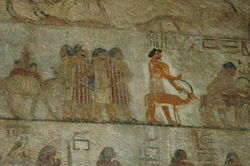
 |  |
|---|---|
 |  |
 |  |
 |  |
 |
The village of Beni Hassan, named after an old Arab Tribe, lies on the Eastern Bank of the Nile, 20 km south of the city of Al-Minya. It houses 39 rock-cut tomb decorated with scenes depicting local and regional life during the Middle Kingdom. (2050–1800 BC) were interred. Although there are 39 tombs only four of the tombs in this necropolis are open to visitors. It’s a long climb of what seems like countless steps to reach the cliff tops but the depth of insights found in the stories told on the tomb walls make it all worthwhile.
The tombs date mostly to Dynasties XI and XII, although there are a few smaller and less elaborate ones belonging to Dynasty VI when provincial rulers had begun to establish their independent power along the Nile Valley. The tombs are reached via a long steep flight of stone steps up the hillside, from where there is a magnificent view up and down the river valley.
The most important of the tombs belonged to provincial rulers of the 16th Upper Egyptian nome. Of 39 tombs on the upper part of the cliff, only 12 were decorated and four are currently open to visitors along with another undecorated tomb (BH18). These offer a rare chance to see the distinctive style of mortuary art characteristic of the early Middle Kingdom with their colourfully painted scenes of daily life, recreation and military activities.
The location of the cemetery on the east bank of the Nile is somewhat unusual – the west being the domain of Osiris. The necropolis was recorded by several early explorers and between 1890 and 1894 was surveyed by Percy Newerry on behalf of the Egypt Exploration Fund. John Garstang excavated some of the Dynasty VI to Dynasty XII tombs during 1902 to 1904 and Nina de Garis Davis copied wall-scenes in 1931. In the early 1980s some of the Dynasty XII tombs were cleaned of their grime by the Egyptian Antiquities Organisation, restoring the wall paintings to their original bright colours.
Tomb of Baqet III (15)
The tomb of Baqet III is the earliest of the tombs which are open. Baqet was provincial governor of Menat-Khufu (modern el-Minya) during the later years of Dynasty XI. A large rectangular cult chapel lies behind the plain tomb façade with two slender lotus columns separating the front part of the chapel from the rear.
Tomb of Khety (17)
During the 11th Dynasty, Kheti was a governor of the Oryx nome. The tomb has depictions of daily life during the period. Khety, also a Dynasty XI governor, was the son of Baqet. The architecture of his tomb is similar to that of his father’s, but with six slender closed lotus pillars in the rear portion. The east and north walls of the tomb are decorated with scenes of fowling and the papyrus harvest, hunting in the desert and local industries below. Khety and his wife are shown presiding over the activities and watch women dancing and playing games. Clappers and dancers and musicians are shown before Khety’s statue being dragged on a sledge.
Tomb of Amenemhet (2)
Amenemhet is described as the 'prince of the Oryx Nome' and was a governor of the Oryx nome. Here one finds one of two inscriptions within the necropolis that help define Egyptian life in this period. It consists of thirty-two lines on the door. There are also unusual scenes depicting hunting in the desert on the north wall. His tomb is unusual for having a false door on the west, where the dead are suppose to enter. The tomb of Amenemhet, who was called Ameni, dates to Dynasty XII and is a little more elaborate than the earlier tombs.
Tomb of Khnumhotep II (3)
A governor under Amenemhet III (about 1820 BC), Khnumhotep's is described as 'the hereditary lord' and his tomb is beautifully done with scenes of daily life. His biographical inscription within the tomb is 222 columns of text and help define Egyptian life during this period. There are also acrobats over the door. Khnumhotep II was a successor of Amenemhet and occupied one of the latest of the Middle Kingdom tombs built at Beni Hasan. Although he was a provincial governor, technically his power would have been less than that of his predecessor as the Middle Kingdom government of Egypt became stronger. His titles include ‘Hereditary Chief’, ‘King’s Acquaintance’ and ‘One who is Beloved of his God’.
Tome of Khnumhotep I (14)
If ever there was an imaginative person, the father of Kheti (see below) was one. A strange tomb with scenes depicting a hunt for unicorns, a serpent-headed quadruped, a 'Sethian' animal and a griffin. Apparently, the Egyptians felt that their were evil forces in the desert, and hunting their helped to preserve order. Others show wrestlers and gazelles involved in strange behavior.






